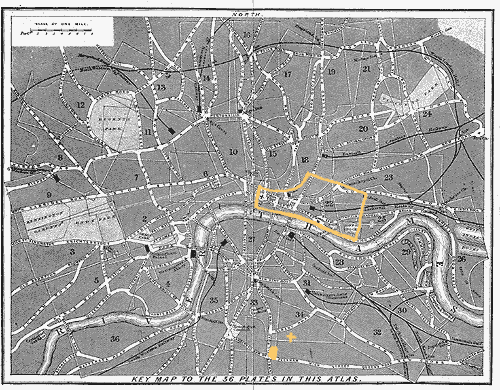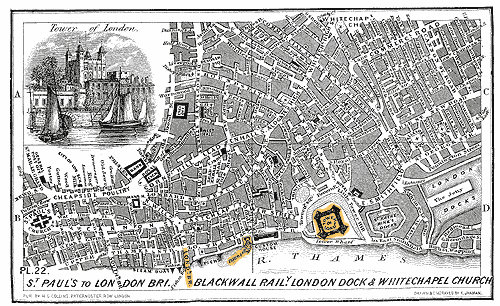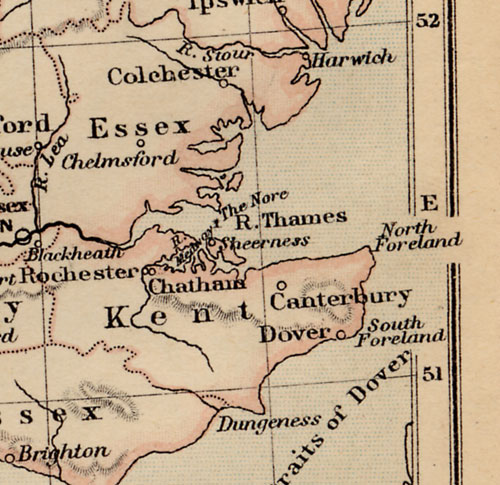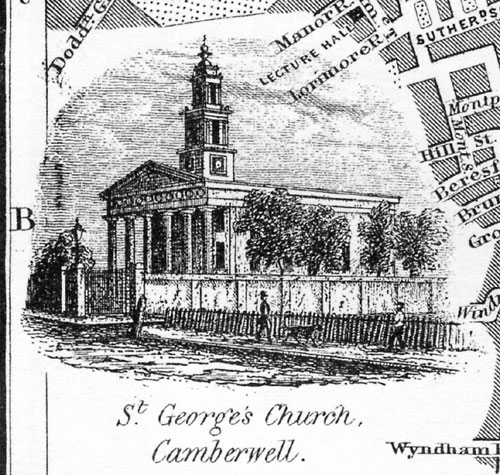|

NOTES ON THE NOVEL: ISSUE 17
Printable View
The city maps used to illustrate this issue are
reproduced from Collins' Illustrated Atlas of London, published
in 1854. Pip's London would have been that of the 1820s, and Dickens'
London, at the time he was composing the novel, was that of 1860-1.
Collins' maps thus represent a London that falls between the historical
moment represented in the novel and the historical moment of the
novel's composition.
Since the chapters in this issue (Chs. 54-56)
take place in late 1829 (Meckier 160), the maps used here show a
city that has undergone about 25 years of change since Pip's time.
Nevertheless, they are very useful in tracking Pip's progress through
the city; the reader should merely keep in mind that some of the
landmarks would not have existed in the late 1820s. The most significant
of these are the railway lines marked on the Key Map -- the
railroad did not enter London until the late 1830s and early 1840s
(Tallis's Illustrated London 186-7). The Key Map also
shows a bridge that Pip would not have recognized -- the Hungerford
Bridge between Waterloo and Westminster Bridges. And London Bridge
was, in Pip's time, Old London Bridge -- a different structure,
but built in essentially the same place. (New London Bridge would
have begun construction a few yards from Old London Bridge when
Pip was living in London, but would not have replaced the old bridge
during his tenure [Meckier 162]. Given that both London Bridges
would have been mapped in the same place, the difference between
the bridges makes no difference to our reading of the map.) Any
further discrepancies will be noted where appropriate.
History and features of Collins' Atlas
(1854)
Collins' Atlas was created in response
to the amplified tourist trade in London resulting from the Great
Exhibition of 1851. Previous to the Atlas, maps tended to
be very large and unwieldy, and though large city maps could be
folded up and carried, Collins designed his maps with a specific
view to portability (Dyos 10). The Atlas consists of one
large map of the whole city of London (the Key Map), followed
by 36 plates. The Key Map is drawn with numbered sections,
and these sections are represented in detail by the plates (the
numbers on the Key Map refer to the numbers of the plates).
The chief drawback to the Atlas is that, although the Key
Map keeps North at the top, the plates do not always observe
this convention (Dyos 13). This disregard of the compass, however
puzzling to someone attempting to navigate London in 1854, is in
many respects an advantage for the modern reader: The detailed plates
-- drawn to represent popular views of the city and/or popular routes
through it -- give us a unique view of the sites of Pip's adventures
in 19th century London. Any major discrepancies between the landmarks
shown on the maps and those that Pip would have been acquainted
with (given that the map was composed in 1854, about twenty-five
years after Pip's time in London) will be indicated where appropriate.
A Note on the Illustrations
The engraved illustrations of London reproduced
in this and other issue(s) were prepared as a result of the Great
Exhibition of 1851. Tallis's Illustrated London (published
in 1851-2, in two volumes) was created specifically to commemorate
the Exhibition, and furnishes, not only a great many engravings
of London scenes, but also a long history of, and commentary on,
the sights of London and its environs. Since Tallis's Illustrated
London was published almost 25 years after the events related
in this issue (Chapter 54-56 take place in 1829 [Meckier 160]),
some of the views commemorated in Tallis's would not have
been available to Pip. Only those illustrations that show cityscapes
and landmarks as they would have appeared to Pip in the 1820s have
been included here.
A tour of chapters 54-56
The Key Map of Collins' Atlas, showing
London as a whole, gives a useful overview of the city locations
mentioned in this issue. The London locations described in Chapters
54-56 appear on the Key Map mostly in area 22 (shown in detail
on the corresponding Plate), and eastward down the river Thames,
to Magwitch's hiding place and beyond. In the later chapters, when
Pip takes his walk with Wemmick, he visits the general areas of
Walworth and Camberwell, south of London, at about the lower middle
of the Key Map. All of the maps reproduced here have been
highlighted for convenience of reference and increased legibility.

Plate 22 of Collins' Atlas (below) shows
several of the landmarks noted by Pip early in the escape mission,
before they retrieve Magwitch from his hiding place: "Old London
Bridge was soon passed, and old Billingsgate market with its oyster-boats
and Dutchmen, and the White Tower and Traitor's Gate, and we were
in among the tiers of shipping" (Ch. 54). Billingsgate Market is
visible on Plate 22 just east of Old London Bridge, and the Tower
of London is just east of Billingsgate. Note that the Blackwall
Railway (noted in the caption of Plate 22) would not yet have existed
in 1829.

The "White Tower" is the oldest part of the Tower
of London, built in 1078 -- a "large square irregular building,
standing almost in the center of the inner ward. The summit of the
walls is embattled, and at each angle is an elevated turret rising
considerably above the roof" (Tallis's Illustrated London, vol.
2, 145-6). The White Tower is visible in the illustration of the
Tower of London on Plate 22 of Collins' Atlas (above) --
it is the structure in the middle, with the four turrets. "Traitor's
Gate," also mentioned by Pip, is an entrance on the river side of
the Tower.
Pip and Herbert proceed down the river, pick
up Magwitch, and make for the "long reaches below Gravesend, between
Kent and Essex, where the river is broad and solitary" (Ch. 54)
toward the Mouth of the Thames. They stop at a lonely inn at the
riverside, and Pip sees, from their lodging, men pass "across the
marshes in the direction of the Nore" (Ch. 54). The Nore is a sandbank
"off the Isle of Grain, which terminates the peninsula on which
the Cooling marshes lie, where the [opening of Great Expectations
took] place" (Mitchell 506). Thus, Pip is back in Kent, close
to the place where he first met Magwitch. The Nore is marked on
a map of England and Wales 1660-1891 in Gardiner's School
Atlas of English History. Detail from this map -- enlarged for
clarity -- is given here.

Locations important to the early part of the novel
are also marked on Gardiner's map: The Medway (where the
Hulks docked), Rochester (home of Miss Havisham), and London appear.
Dover, the decoy location to which Magwitch was ostensibly taken
when Herbert hid him at Mill Pond Bank -- "At the old lodgings it
was understood that he was summoned to Dover" (Ch. 45) -- is also
marked on this map, at the lower right.
Back in London, after the failure of Magwitch's
escape attempt, Wemmick asks Pip to take a walk with him one Monday
morning. They walk, as it turns out, to Wemmick's wedding: "We went
towards Camberwell Green, and when we were thereabouts, Wemmick
said suddenly, 'Halloa! Here's a church!'" (Ch. 55). Camberwell
Green is not illustrated or marked on Collins' Atlas; however,
it lies east of the intersection of Camberwell Road and Camberwell
New Road, at the bottom of the Key Map. It was well known
at Pip's time, as well as at the time Collins' Atlas was
created: the second biggest metropolitan fair (after Greenwich)
was held there (Tallis's Illustrated London, vol. 2, 78).
The church that is near -- "thereabouts" -- to Camberwell Green
is probably St. George's Church of Camberwell, open since 1824 (Meckier
188). This church, which we have marked in on the Key Map with
a cross (see Key Map above), is south of Albany Road, a bit
to the east of the Green. Collins' Atlas offers this engraved
illustration of St. George's.

Hymen: In Greek mythology, Hymen is the
god of marriage (OED, "Hymen").
The two men who went up into the Temple to
pray: Pip, having recounted Magwitch's death at the end of Chapter
56, invokes the parable of Luke 18:10-13, which reads as follows:
Two
men went up into the temple to pray: the one a Pharisee, and the
other a publican. The Pharisee stood and prayed thus with himself,
God, I thank thee, that I am not as other men are, extortioners,
unjust, adulterers, or even as this publican. I fast twice in
the week, I give tithes of all that I possess. And the publican,
standing afar off, would not lift up so much as his eyes unto
heaven, but smote upon his breast, saying, God be merciful to
me a sinner. I tell you, this man went down to his house justified
rather than the other: for every one that exalteth himself shall
be abased: and he that humbleth himself shall be exalted.
Buttons: Custom's House officers wore
a uniform with buttons (Mitchell 505-6). Thus the Jack of the causeway
-- convinced that the men he saw belonged to the Custom's House
-- insists that they "Chucked 'em [the buttons] overboard. Swallered
'em. Sowed 'em, to come up small salad" (Ch. 54). The Thames River
Police, however, wore no distinct uniform -- "their dress would
appear to be that of the rivermen and seamen of the day" (Cunnington
260).
Coal-whippers: Pip describes seeing "colliers
by the score and score, with the coal-whippers plunging off stages
on deck, as counterweights to measures of coal swinging up" (Ch.
54). A coal-whipper is a person employed moving coal -- "One who
raises coal out of a ship's hold by means of a pulley" (OED,
"coal-whipper") -- or an apparatus for moving coal, attached
to the deck of a vessel. Pip's coal-whippers, given that they are
"plunging off stages on deck," are people.
Galley, four-oared: The Oxford English
Dictionary defines a "galley" as a large open row-boat, like
the kind "formerly used on the Thames by custom-house officers,"
and uses a passage from Chapter 54 of Great Expectations --
"the Jack ... asked me if we had seen a four-oared galley going
up with the tide?" --to illustrate this usage. Though the vessel
in question does not turn out to hold Customs House officers (who
would be looking for smugglers), the Jack of the causeway thinks
it does: "'A Four [-oared galley] and two sitters don't go hanging
and hovering, up with one tide and down with another, and both with
and against another, without there being Custum 'Us at the bottom
of it'" (Ch. 54).
Jack: Pip describes encountering "a grizzled
male creature, the 'Jack' of the causeway" (Ch. 54) at the riverside
inn. The Oxford English Dictionary defines "Jack" as "variously
applied to a serving-man or male attendant, a labourer, a man who
does odd jobs, etc.," and uses the example of the "grizzled male
creature" from Great Expectations to illustrate the usage
of the word.
Mill-weirs: When Pip goes overboard, he
says that he seemed, for an instant, "to struggle with a thousand
mill-weirs and a thousand flashes of light" (Ch. 54). A mill-weir
is a "dam constructed across a stream to interrupt its flow and
raise its level so as to render it available for turning a mill-wheel.
Also the entire area covered by the water held in check by the dam"
(OED, "mill-weir"). Pip's sensation, then, is of approaching
the turbulence of a mill.
Red-book: Herbert is grateful that Clara
"comes from no family ... and never looked into the red book" (Ch.
55) as his mother does. The red book was "A popular name for the
'Royal Kalendar, or Complete ... Annual Register' (published from
1767 to 1893)" (OED, "red book"). It contained, alphabetically,
the names and addresses of the English gentry.
Recorder's Report: The Recorder of London
was "originally a person [usually a judge or magistrate] with legal
knowledge appointed by the mayor and aldermen to 'record' or keep
in mind the proceedings of their courts and the customs of the city,
his oral statement of these being taken as the highest evidence
of fact" (OED, "Recorder"). The Recorder reported to the
Secretary of State about the sentencing of criminals, and could
recommend clemency for those sentenced to execution (Mitchell 499).
Sessions: Twelve sessions a year, during
which prisoners were put on trial, were held in the Sessions House
in London (Tallis's Illustrated London, vol. 1, 27). Magwitch
comes up for trial in the April session, 1829, and Jaggers attempts
to postpone until the following session -- Trinity term (May 22-June
12). Magwitch, mortally injured during his struggle on the river,
would be unlikely to live so long (Meckier 168). Martin's Annals
of Crime gives us (below) an illustration of the Sessions during
trial.

Thowels: "Thowel" is an obsolete spelling
of "thole," meaning "A vertical pin or peg in the side of a boat
against which in rowing the oar presses as the fulcrum of its action,
[especially] one of a pair between which the oar works; hence, a
rowlock" (OED, "thowel").
Bibliographical
information
|

